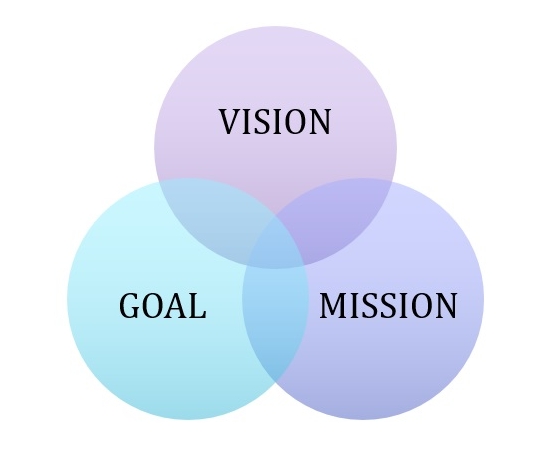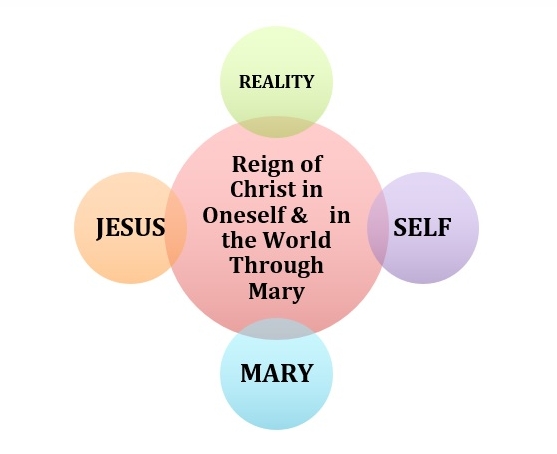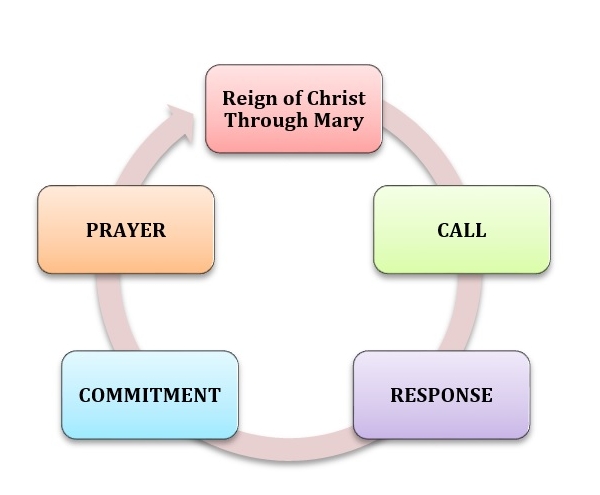Introduction
Process
The method adopted for this manual is process-oriented. Hence, it encourages the participants to respond to the input with their lived experience. Much of the input is drawn from the Scriptures and the writings of St. Louis-Marie de Montfort.
A process is not a course; rather, it is a “call” to explore the meaning of life by dialoguing with an inner “secret” or special revelation. For Montfort, our life experience finds its highest purpose when it is grounded in the “secret” of living in Jesus Christ through Mary. In this regard he writes: “Here is a secret, chosen soul, which the most High God taught me and which I have not found in any book, ancient or modern. Inspired by the Holy Spirit, I am confiding it to you. […] Use this secret to become holy and worthy of heaven, and the more you make use of it the more benefit you will derive from it” (SM 1).
Vision, Mission and Goal of the Process
The “Vision” of this spiritual experience aims at realizing the Reign of Jesus, Wisdom of God, in our personal lives and in the world, through Mary.
The “Mission” is to help the participants to practice the Reign of God in their lives, by understanding the role of Mary in the mystery of Christ and the Church, and by renewing their Baptismal Promises through the hands of Mary.

The “Goal” of the process is to actively attend and implement the stages and dynamics of the methodology proposed in this manual.
Stages of the Process

In TD 227-230 Montfort suggests that “those who desire to take up this special devotion should spend at least twelve days in emptying themselves of the spirit of the world […]; one week to acquire knowledge of themselves and sorrow for their sins […]; one week to acquire an understanding of the Blessed Virgin and ask the Holy Spirit for this grace […] and one week to understand Jesus Christ better”.
When the process is taken up individually, it can be covered in 33 consecutive days, following the suggestion of Montfort, albeit one is free to invest his or her creativity in organizing both the contents and the timeframe.
The same goes for groups of participants who intend to undergo the process in the manner of a 33-day retreat, while residing in a retreat house, together with a director.
When the process is taken up by a group of participants who can meet only once a week, at a given venue, at least two persons should be involved as facilitators.
Methodology
For each session the manual proposes a flow that’s divided in four moments or parts: call, response, commitment, and prayer.
In the first part, after an invocation to the Spirit, the facilitator introduces the topic and invites the audience to pay attention to the “call” emerging from the theme of the day by means of Scripture and/or Montfortian readings and comments that follow. The call may be perceived in a threefold manner: (1) as a confirmation or deepening of one’s experience, (2) as a challenge to one’s way of being and doing, (3) as a suggested alternative to one’s lifestyle and conduct.
In the second part, the facilitator, with the aid of further Scripture and/or Montfortian readings and comments, solicits from the audience a reaction or “response”. Such response presumes an acceptance of the call challenging one’s way of being and doing, and a decision to let the mind and heart be formed towards new directions.
The third part focuses on helping the participants to trust their ability to integrate the new insights in their day-to-day living. It is the moment of “commitment” not only to a personal decision but also to a mission that enables ecclesial and social transformation.
Basically, it may take five to ten minutes to introduce and expose the contents of each of the three parts. More ample time instead is allotted to personal reflection and sharing, as indicated at the end of each section. It may be advisable to set aside twenty to thirty minutes for this exercise.

The fourth part or moment merges the process in an atmosphere of “prayer”, through the recitation of the Rosary. This is to follow the advice of Montfort who says: “I know of no better way of establishing the kingdom of God, Eternal Wisdom, than to unite vocal and mental prayer by saying the holy Rosary and meditating on its mysteries” (LEW 193).
Steps or Flow of the Session
The session may unfold along the following steps:
- Facilitator welcomes Participants.
- Facilitator leads invocation to the Holy Spirit.
- Facilitator introduces the theme, briefly presenting its three complementary aims. From the second through the last session, he/she takes a few minutes to tie up with the previous topic.
- Facilitator introduces part one, CALL, and reads its specific aim.
- Facilitator asks one or two readers to proclaim the reading/s. Before the actual reading, it is recommendable to announce the source and author of the text. For instance, “A reading from the Gospel of Mark” or “A reading from True Devotion to Mary, by St. Louis-Marie de Montfort”, etc. That is why, in the “reading” sections of this manual, references precede the text, unlike in the other sections, where we habitually place the references at the end of the quoted text.
- The reading is followed by a minute of silence. Then Facilitator invites the participants in the audience to echo back a word or phrase that has impressed them most.
- Facilitator gathers the highlights of the echo and connects them to the “Comment” which Facilitator may read or present in his/her words.
- Participants maintain five minutes of silence to journal their personal answers/insights to the proposed questions.
- Participants spend ten minutes sharing their answers/ experiences with a partner.
- Facilitator calls Participants back to the large group and attends questions and clarifications, if needed.
- Facilitator introduces part two, RESPONSE, and reads its specific aim, connecting it to the main theme.
- Same procedure follows as from 4 to 10.
- Coffee/Tea Break (30 minutes).
- Facilitator introduces part three, COMMITMENT, and reads its specific aim, connecting it to the main theme.
- Same procedure follows as from 4 to 9.
- After sharing with their partners, Participants are invited by Facilitator to state in public the summary of their personal commitment.
- Facilitator introduces part four, PRAYER, connecting it to the main theme.
- Individuals among Participants are asked to lead the various decades.
- Facilitator guides Participants through the concluding prayer.
- Facilitator reminds Participants of their next session.
In order to cover adequately the various steps and secure a fruitful process, the time allotted to each session is to be no less than two hours. We strongly advise against holding two sessions together, on the same day.
Process Calendar
The first manual, compiled in the Philippines in 1986, as well as its subsequent editions, literally followed the advice of Montfort (cf. TD 227-230). However, in the course of time it has generated among the facilitators and participants some feelings of tediousness. The attempt of this new manual is to assign to each week the same number of days, i.e., seven. It also proposes some new activities that can contribute more vivacity to the process. Specifically, the novelty recommends the inclusion of three pilgrimages to Marian shrines, marking both the end of one period and the beginning of another.
In summary, session one, on the first day, is meant for the “launching” of the process. Then, 28 sessions are distributed along four periods or “weeks”. Three more days are devoted for pilgrimage experiences. And one day, previous to the event of the consecration, is spent in an atmosphere of “solitude”. So, the total number of days amounts to 33, in line with the suggestion of Montfort.
- Day 1: Launching of the process and registration.
- Days 2 to 8: “First Week” or “Facing Reality”.
- Day 9: First pilgrimage to a Marian shrine or site.
- Days 10 to 16: “Second Week” or “Awareness of Self”.
- Day 17: Second pilgrimage to a Marian shrine.
- Days 18 to 24: “Third Week” or “In Communion with Mary”.
- Day 25: Third pilgrimage to a Marian shrine.
- Days 26 to 32: “Fourth Week” or “Towards the Likeness of Jesus Christ”.
- Day 33: Time spent “in solitude”, in preparation for the consecration.
The idea of the “pilgrimage” intends to highlight two main reasons. First, it aims at ritualizing the inner journey and transformation made manifest through the process. Second, it affirms in the participants the Marian attitude of translating the process into action: after the Annunciation, “Mary set out and went with haste to a Judean town in the hill country” (Lk 1:39).
For Whom
This manual is primarily meant for those men and women, young and old, lay, religious and priests, who wish to undergo the process of preparation for the consecration to Jesus Christ, Incarnate Wisdom, through the hands of Mary.
The method and approach used in the manual suggest that the sessions will be experienced in a most profitable way when they are held in a group or community atmosphere. However, the manual can be used as well for individual journeys and directed retreats.
Lastly, whether the process is taken up communally or individually, it is strongly recommendable that participants attend to journal writing, both in the sessions and in the moments of personal integration they can negotiate during the week.
